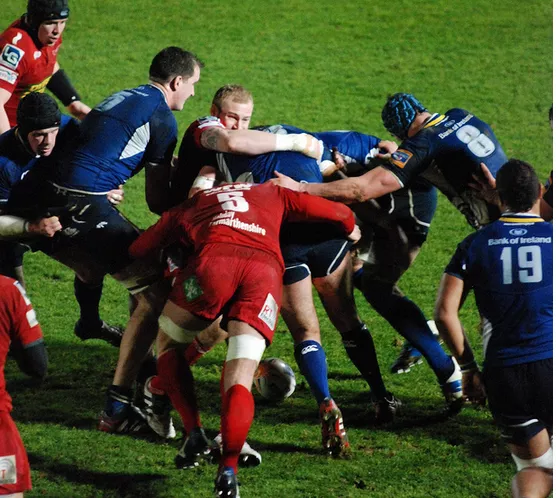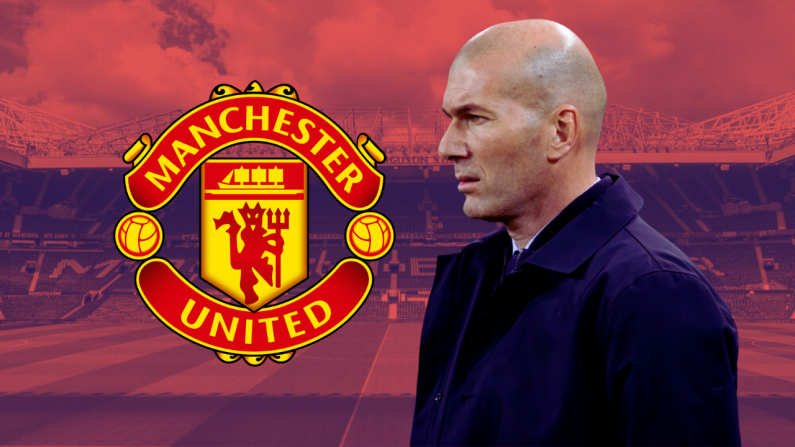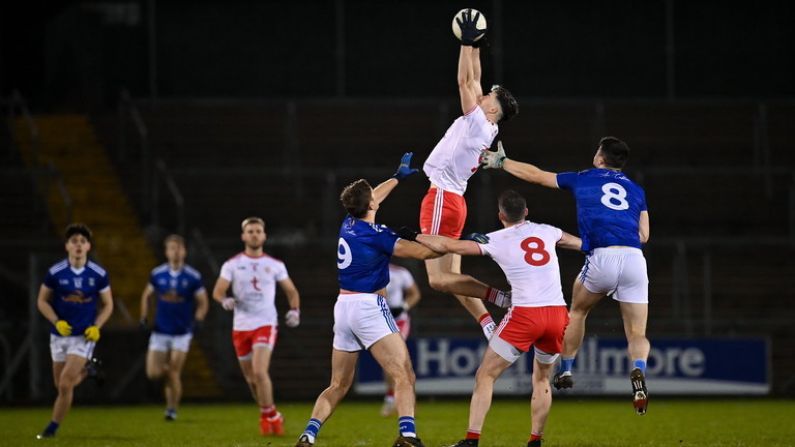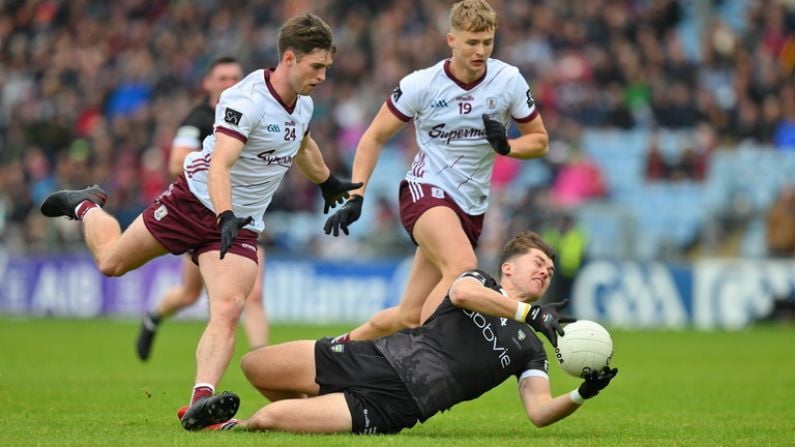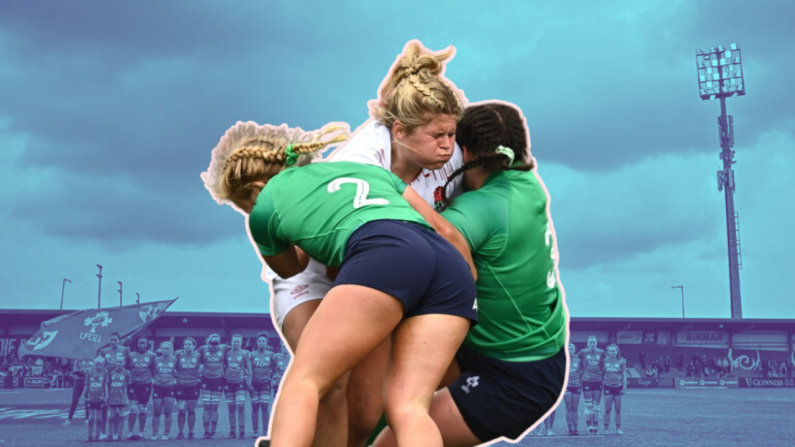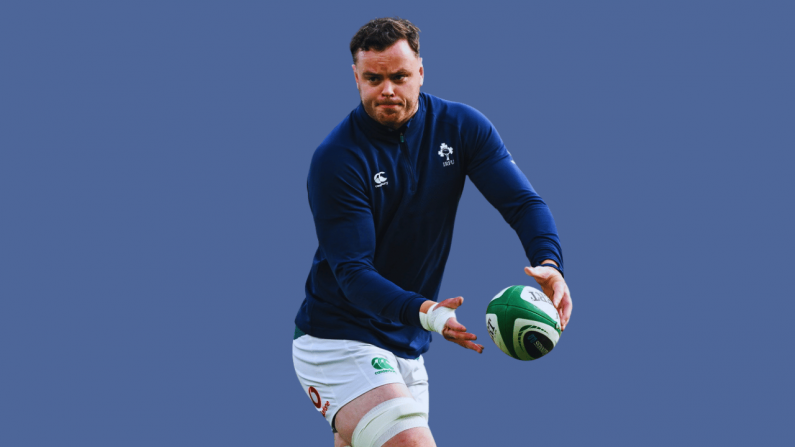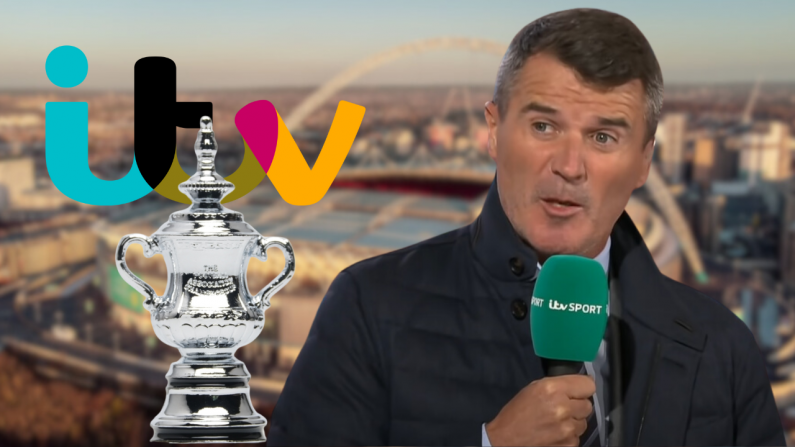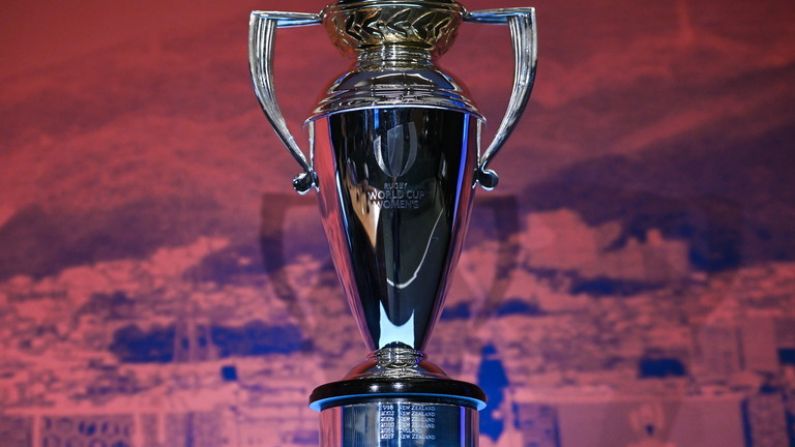(photo by M+MD)
Brian O’Driscoll will watch his Leinster team-mates from the bench as they run out to face the Scarlets on Saturday evening at the RDS. Rob Kearney and Luke Fitzgerald both hold their places in the side after returning from long-term absences while Isa Nacewa’s arm has recovered enough to take his place on the right wing. Isaac Boss is, somewhat surprisingly, preferred to Eoin Reddan at scrum half.
In the pack Richardt Strauss has lost his fitness battle so Sean Cronin takes his place at hooker with Aaron Dundon backing him up from the bench. In an effort to secure as much of their own lineout ball as possible, Devin Toner starts at lock. Kevin McLaughlin misses out with a shoulder injury so it’s a nicely balanced back row of Sean O’Brien, Shane Jennings and Jamie Heaslip.
Scarlets are suffering badly from injuries at the moment, George North being the most high profile in recent weeks. Simon Easterby has just 11 fit backs at his disposal for European games and has included ten in his match day squad. The former Ireland flanker hasn’t been able to pick a single dedicated back row on his bench, again due to injuries. Aled Thomas starts at fly-half in the absence of Rhys Priestland who’s out for the season after snapping his Achilles tendon.
The Llanelli Scarlets are rooted to the bottom of the Heineken Cup’s Pool 5 with just two losing bonus points to show for their efforts in the four matches played thus far. Of the 24 teams in the competition, the Scarlets lie fourth from bottom in both points conceded (121) and points difference (-58). Along with Edinburgh, Treviso, Zebre, Glasgow and Cardiff Simon Easterby’s side is already mathematically certain of heading out of the competition after the pool stages.
Yet they’ve scored two more tries than Leinster (5 to 3), and three more points (65 to 62). Leinster themselves have a points difference of precisely zero. But, odd as it might seem to say so, that doesn’t really matter.
I’ll come back to that.
Leinster, Scarlets and Exeter have each played 17 matches this season, between the league and the Heineken Cup. Disregarding the relative merits of the Aviva Premiership versus the Rabodirect Pro 12, below is a composite table of all three teams’ records so far this season:
Leinster sit comfortably atop the pile in points difference and tries scored, but in the Heineken Cup they’re in a position where realistically it’s not possible for them to finish top of the pool. To do so would require Clermont Auvergne to lose to both Exeter and Scarlets in consecutive weeks; this turn of events, which would necessarily include Exeter ending the historic 53 match unbeaten run at the Stade Marcel Michelin, would be only slightly less likely than Lance Armstrong inviting both Paul Kimmage and David Walsh to his interview with Oprah for a truth and reconciliation session.
In playing for a best-runners-up slot, Leinster are effectively competing against six other teams who currently occupy either second or third position in a group and have the same or more total points.
The above table is ordered first by total points then tries scored, the first ERC tie-breaker.
One might make ask whether, with Pools 1, 2 and 4 being quite tight, perhaps Leinster’s actual competition might not come from the Wild Card list above but instead from a team currently topping a group?
It’s possible.
Here’s the list of all six pool-toppers, with Leinster included for illustrative context.
Leaving out the difficulty of closing a four or five point gap in the standings, Ulster, Leicester and Saracens all enjoy a minimum of six tries advantage over Leinster along with a points difference advantage to boot. Besides that, the second place teams in each group all have points and try advantages over Leinster as well. All this goes to say that even if there happened to be a couple of cast changes among Leinster’s competition, the task would remain the same if not more difficult.
Before Christmas I outlined just how unlikely it was that Leinster would qualify from their Heineken Cup pool, let alone successfully defend their title. Now, in the warm, happy glow of the New Year, it’s time to instead see how they can qualify.
After having outlined the above position with regard to Leinster’s current state of affairs, this column will assume that Leinster will come out of the next two rounds with two wins.
Apart from those wins, in order to qualify Leinster need tries.
Lots of them.
And so long as the wins are secured, in this context the actual number of points scored and conceded is likely to be irrelevant*.
* To readers from Wales or south-west England… be assured that this isn’t demonstrating a lack of respect towards Leinster’s opponents, it’s just setting out a scenario. To set out a scenario where either Scarlets or Exeter beat Leinster would kill this 2300 word piece stone dead. So bear with me.
As set out in a pre-Christmas column, since the bonus point system was introduced in 2003/04 no team has ever qualified for the knock-out stages with just 18 points. Of those who got nineteen points just two of a possible ten qualified. Getting twenty points would be better but still tough based on the upcoming fixtures across the groups. But even if Leinster get to either the 19 or 20 point mark they would still very likely find themselves losing out on a try-scored tiebreaker, such as been their lack of firepower so far.
Assuming that Leinster’s Wild Card competitors will not suddenly call a halt to their superior try-scoring rates, it’s reasonable to state that Leinster need more than the minimum of four tries per game. Conservatively, the real minimum is more like ten tries over the two games.
Five tries scored against both Scarlets and Exeter would see Leinster emerge with twenty points. Three tries in one and seven in the other, in whichever order, would see Leinster with nineteen points but with a try-scoring record that would give them a fighting chance of overcoming the majority of their competitors in the knock-out race.
Leinster have 160 minutes of match time in which to score those ten tries.
In their four Heineken Cup matches this season Joe Schmidt’s team have scored just three tries at a rate of one every 107 minutes. Scoring ten in 160 minutes would require a rate of one every 16 minutes. Apart from simply playing better attacking rugby, anything that could improve this scoring rate has to be considered.
A short aside about kicking.
The art of goal kicking requires practice and dedication. Most top level kickers in rugby union have a deliberate, measured routine that they through before every single kick, no matter where it might be on the field. Some kickers have had much longer routines than others, with the former Argentinian fly-half Gonzalo Quesada one of the most remarkable examples.
In order to stop such routines becoming silly by virtue of their sheer length the IRB has a sixty second limit for penalty kicks and this season, courtesy of the Law Amendment Trials, there is a ninety second limit for conversions from the time the try is awarded.
Jonathan Sexton, himself a superb place kicker, has just such a routine. It’s slow, deliberate and measured. As it should be. And it’s successful.
In the first of Leinster’s back to back games against Clermont, referee Nigel Owens had a word with Sexton about the time he was taking for his kicks. It was a fine example of sensible, preventative refereeing; after all, none but the most sadistic of officials would want to rule out a successful kick simply because of the time limit being breached. It’s not the first time that a ref has had a word with Sexton about this, and there’s nothing wrong with that. It simply illustrates that Sexton, like many kickers, uses all the available time at his disposal to go through the routine that gives himself the best possible chance of successfully executing the kick at goal.
But Leinster don’t need goals. What they most definitely need are tries and all the minutes they can in which to score them.
It’s fairly well known that a kicker can choose to drop-kick a conversion; this is most often seen if a ball falls off the tee during the run-up and the player takes a snap drop-kick. What’s less well known among the general rugby public is that a team can also choose not to have a conversion at all.
As per IRB Law 9, scoring a try simply gives a team the right to attempt a kick at goal for an extra two points. The conversion is not mandatory; the scoring team can choose not to take such an attempt. It’s not common, but Ulster did just this last October when chasing a try-scoring bonus point against Connacht in their first home match since the death of Nevin Spence. After scoring in the 78th minute they simply refused the conversion in order to give them more time to try to get that vital fourth touchdown.
The tactic is also sometimes seen in rugby sevens when a team scores a try, is still down by three points or more so they refuse the conversion and go straight back to the half way line for the kick off. It’s a much shorter game so every minute is that much more important.
But every single minute is important to Leinster now.
Consider the amount of time a ball is actually in play during a match. During the 2011 Rugby World Cup, of the 80 minutes per game during which the clock was running the average time the ball actually spent in play was just 35 minutes 25 seconds.
Where did the time go?
The chief culprits were scrums (14mins), lineouts (10mins), penalty attempts (11mins) and conversion attempts (8mins) with the remainder of instances being relatively insignificant.
That’s a total of nineteen minutes of play, of a total of 80 minutes, simply spent waiting for a player to take a kick at goal.
If you provide Leinster with even half of that 19 minutes it’s potentially an extra nine and a half minutes in a single match. That’s a significant amount of time. To put nine and a half minutes in perspective, Leinster had three such periods during their 59-22 match against Cardiff at the RDS this season in which they scored two tries.
It’s 12% more time in a match to get the tries that could be so crucial to getting out of their group and into the knock-outs where the O’Driscolls, Kearneys and Fitzgeralds will hopefully be fitter, faster and ready to mount a title defence. In a knock-out scenario, anything can happen.
But why Saturday against the Scarlets? Why not wait until the final round of the pool stages against Exeter when at Leinster would probably have a better idea of what they need?
Fair question.
You have won a prize to be rugby coach for a day. Part of the prize is that you can choose the team to coach as well as the opposition for the game. You get two choices for each, listed below. Who would you pick?
It’s reasonable to say that most people would choose Team A to play against Team D, every time.
It’s also reasonable to say that the astute reader will have worked out where this is going.
The likelihood of being able to run in a host of tries against Scarlets at home is so much greater than doing the same against Exeter at Sandy Park as to be a frankly ridiculous comparison. Even more than that, getting a bonus point in Exeter will not be easy, let alone any extra tries; the English side has conceded fewer than 14 points per match this season on their home turf and Leinster will remember all too well the stern resistance they put up in the 9-6 battle at the RDS.
If Joe Schmidt and Leo Cullen were to have a pre-match word with Saturday’s referee, Jerome Garces, to say that Leinster’s default position on the day will be to refuse all conversions unless they say otherwise, it would potentially provide Leinster with the region of an extra ten minutes of play in which to score the extra tries they need.
The strategy would be controversial; it would need balls both to do it in the first place and to stand by it afterwards, no matter what the result would be. It might also be seen by some as having a lack of respect towards their opponents, Llanelli.
But really it’s just about numbers. And using those numbers to the best advantage might give Leinster a better chance to defend the Heineken Cup.
Leinster: 15. Rob Kearney, 14. Isa Nacewa, 13. Fergus McFadden, 12. Gordon D'Arcy, 11. Luke Fitzgerald, 10. Johnny Sexton, 9. Isaac Boss, 1. Cian Healy, 2. Sean Cronin, 3. Mike Ross, 4. Leo Cullen, 5. Devin Toner, 6. Sean O'Brien, 7. Shane Jennings, 8. Jamie Heaslip
Replacements: 16. Aaron Dundon, 17. Heinke Van der Merwe, 18. Michael Bent, 19. Tom Denton, 20. Rhys Ruddock, 21. Eoin Reddan, 22. Ian Madigan, 23. Brian O'Driscoll
Scarlets: 15. Liam Williams, 14. Andrew Fenby, 13. Gareth Maule, 12. Scott Williams, 11. Kristian Phillips, 10. Aled Thomas, 9. Tavis Knoyle, 1. Phil John, 2. Ken Owens, 3. Jacobie Adriaanse, 4. George Earle, 5. Richard Kelly, 6. Rob McCusker, 7. Josh Turnbull, 8. Kieran Murphy
Replacements: 16. Matthew Rees, 17. Rhodri Jones, 18. Samson Lee, 19. Johan Snyman, 20. Sione Timani, 21. Gareth Davies, 22. Jonathan Davies, 23. Adam Warren



